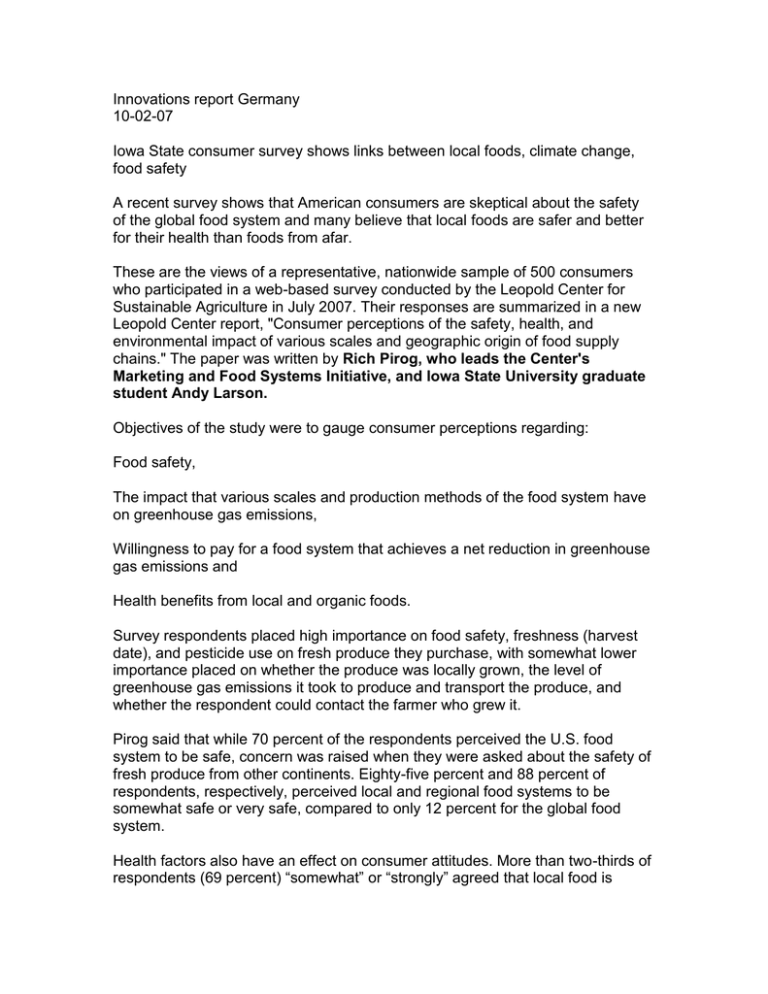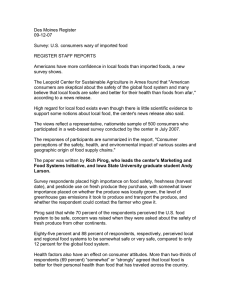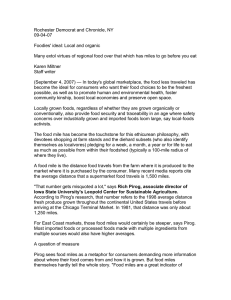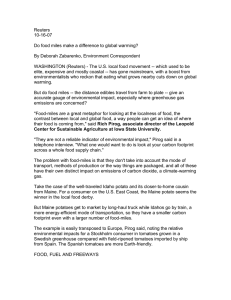Innovations report Germany 10-02-07
advertisement

Innovations report Germany 10-02-07 Iowa State consumer survey shows links between local foods, climate change, food safety A recent survey shows that American consumers are skeptical about the safety of the global food system and many believe that local foods are safer and better for their health than foods from afar. These are the views of a representative, nationwide sample of 500 consumers who participated in a web-based survey conducted by the Leopold Center for Sustainable Agriculture in July 2007. Their responses are summarized in a new Leopold Center report, "Consumer perceptions of the safety, health, and environmental impact of various scales and geographic origin of food supply chains." The paper was written by Rich Pirog, who leads the Center's Marketing and Food Systems Initiative, and Iowa State University graduate student Andy Larson. Objectives of the study were to gauge consumer perceptions regarding: Food safety, The impact that various scales and production methods of the food system have on greenhouse gas emissions, Willingness to pay for a food system that achieves a net reduction in greenhouse gas emissions and Health benefits from local and organic foods. Survey respondents placed high importance on food safety, freshness (harvest date), and pesticide use on fresh produce they purchase, with somewhat lower importance placed on whether the produce was locally grown, the level of greenhouse gas emissions it took to produce and transport the produce, and whether the respondent could contact the farmer who grew it. Pirog said that while 70 percent of the respondents perceived the U.S. food system to be safe, concern was raised when they were asked about the safety of fresh produce from other continents. Eighty-five percent and 88 percent of respondents, respectively, perceived local and regional food systems to be somewhat safe or very safe, compared to only 12 percent for the global food system. Health factors also have an effect on consumer attitudes. More than two-thirds of respondents (69 percent) “somewhat” or “strongly” agreed that local food is better for their personal health than food that has traveled across the country. This is in spite of the fact that there is little or no research documenting such benefits, Pirog noted. Are consumers willing to pay more for food from supply chains that emit half as much greenhouse gas as conventional chains? Nearly half of respondents in the survey were willing to pay a 10 to 30 percent premium, but a similar percentage was not. "With the dramatic rise in popularity of local foods, the farmers who grow these foods and the organizations that champion both the farmers and the foods will be called upon to prove the existence of economic, environmental and health benefits stemming from these products, and to ensure their continued safety as part of the food supply," Pirog said. He pointed out that the findings show a critical need for more research. "Government agencies, universities, health professionals, private companies and non-profit organizations need to work with farmers growing and processing local foods to develop an appropriate research agenda for these food supply chains," he added. In 2001, Pirog led some of the first research in the United States on the concept of "food miles," the distance that food travels from where it is grown to where it is purchased for consumption. He also has investigated consumer perceptions of local, place-based and organic foods. The 45-page report is available on the Leopold Center web site at: http://www.leopold.iastate.edu/pubs/staff/consumer/consumer.htm. The Leopold Center also offers a competitive grants program across all three research initiatives in Marketing and Food Systems, Ecology, and Policy. Through its research and education programs, the Leopold Center supports the development of profitable farming systems that conserve natural resources. Center funding comes from state appropriations and from fees on nitrogen fertilizer and pesticides, as established by the 1987 Iowa Groundwater Protection Act.





